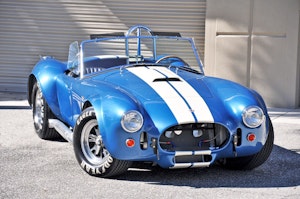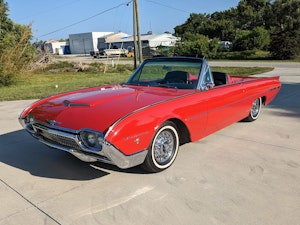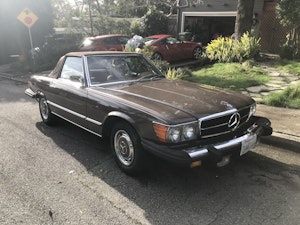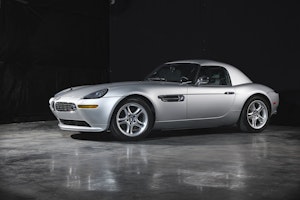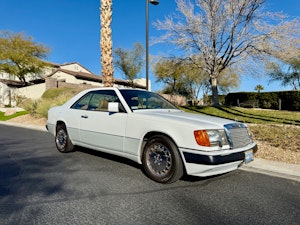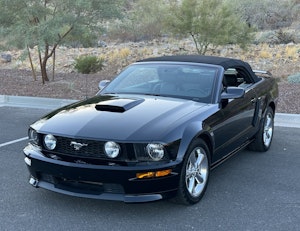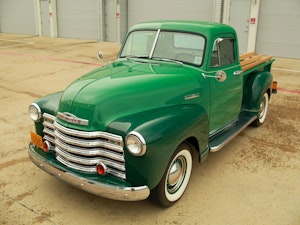The Ferrari 750 Monza
“I’m sure it is,” say I reassuringly, trying to divert the guy’s attention away from the drainpipe-sized exhaust that exits prominently from the Ferrari’s nearside. And at that precise moment, its custodian Kerry McSwan fires up the three-litre, four-cylinder motor. Ka-boom!
Personally, I reckon that if you buy a house next door to a test track then you should expect a bit of noise, but I promise we’ll keep the revs down on the straight beyond which all those sensitive (and wealthy) homeowners dwell. I don’t say anything about the rest of the track, mind you.
After all, it would be criminal not to make the most of the chance to drive a 1950s Ferrari with Le Mans history. This 750 Monza was entered by Mike Sparken and Masten Gregory in the 1955 Le Mans and competed in numerous other international events around that time. Present owner Tom Walduck has driven it with Kerry in three Mille Miglia retrospectives so it’s no trailer queen but it’s still an exceptionally original car. Turns out it’s an exceptionally well-sorted machine, too.
Ferrari’s model range was bafflingly complex in the early 1950s as the company struggled to match engine capacities to racing formulae. In the years leading up to 1954, when the 750 Monza was introduced, there were no fewer than nine varieties of V12 engine and three four-cylinders. The 750 Monza – its number representing the cubic capacity in cc of a single cylinder, as was Ferrari’s custom – had the biggest of the four-pot motors: a three-litre, twin-cam engine that could thrust this road-racer up to 160mph or more, depending on which final drive ratio was fitted.
So why make do with four cylinders when Ferrari had so much experience with 12? Partly because an in-line four can offer lots of low-down torque and partly because the smaller number of components means it can be lighter and more efficient. Aurelio Lampredi designed Ferrari’s first four-cylinder engine for the 1951 Formula 2 season and the three-litre used in the 750 Monza is an evolution of it, the new car taking its name from a one-two victory at Monza in June 1954 in the hands of Hawthorn/Maglioli and Gonzalez/Trintignant.
Marketplace
Buy and sell classics with confidence
Chassis no. 0504M, which is causing our test track controller such anxiety as McSwan warms up the oil, was delivered in early 1955 to privateer Mike Sparken, the racing identity of a Frenchman whose real name was (and is, because he’s still very much alive) Michel Poborejsky. On February 27, 1955, Sparken had immediate success with his new toy in the Agadir Grand Prix, which he won outright, and another win in the British Empire Trophy Race at Oulton Park a couple of months later. With various other races under his belt, he returned the Monza to the Ferrari factory so it could be prepared for the 1955 Le Mans 24 Hours.
In 1955 there were five Ferraris on the starting grid at Le Mans but none of them were to finish. In fact the Sparken/Gregory Monza was the first to retire, holing a piston in the third hour; but this disappointment was quickly put into perspective by the horrific accident that followed soon after, when Pierre Levegh’s Mercedes ploughed into the crowd, killing 83 people and injuring 100 more.
Today, Sparken’s Monza is still much as it was on that dreadful day in June, 49 years ago. Peer under the metal tonneau that covers the nearside of the cockpit and you’ll see the outline of a hole, now neatly filled, cut for the filler neck of a supplementary fuel tank. The oil filler cap on the offside front wing has miniature holes for the lead seals that were threaded through by Le Mans scrutineers, and the name ‘Sparken’ is scratched on top of the gearbox casing.
That name may well have been scrawled by a Ferrari mechanic as he stripped the car prior to the 24-hour race, since a sheaf of invoices and correspondence reveals that Sparken spent a huge amount with the factory in the months leading up to June 1955. Ferrari hired out one of its mechanics to Sparken at Oulton and Goodwood, too, as well as taking care of transportation to the Agadir and Dakar grands prix in Africa and to Le Mans . Sparken clearly wasn’t running his Monza on a shoestring.
Apart from the addition of an ammeter, the dash looks just as it did in 1955. You still fire up the big twin cam in the same way, too, by turning the ignition key one click to the right and pulling on a lever deep under the scuttle, which acts directly on the starter motor. Already warm, the motor cannons into life, sounding loud and meaty. It’ll oil its plugs if you leave it ticking over, so you must keep blipping the throttle while you prepare for take-off; as the revs rise and fall, vibrations percolate through the alloy-panelled bodywork.
Contemporary race reports often list 750 Monzas as having retired with clutch problems and Sparken’s car was not immune at the time, so it’s lucky I haven’t done my research beforehand because the Monza ’s clutch makes an Austin Seven’s seem nicely progressive. Smooth getaways are all but impossible because the multiplate clutch relies on metal-to-metal contact. ‘Just keep the revs up and spin the wheels,’ advises Kerry McSwan; ‘the transmission can take it.’ Well, if you insist…
With twin Webers partially open, the Monza fishtails lazily away and onto the test track, engine roaring in a thrilling if not sophisticated fashion – it sounds like any other big ‘four’, the harmonies of valve train and carburettors drowned out by the thunder of the exhaust. Snatch second, then third, and even the exhaust note starts to yield to the buffeting wind and the scream of gears in the rear transaxle.
The earliest Monzas had four-speed ’boxes but this 1955 model has the more usual five-speeder, with ‘dog-leg’ first out to the left of the traditional Ferrari chromed gate. There’s no synchromesh but the faster you make changes, the better it works. Upshifts need nothing more than a good sense of timing but, coming down through the ’box, your feet must tap the pedals with the rapidity of a Michael Flatley to whip through the double-declutching necessary for a clean change.
Depending on which gears are housed in the diff’ casing – which is mounted rigidly in the tubular chassis, and split vertically so that ratios can be swiftly altered – the Monza is good for anything between 113 and 164mph. That’s not a theoretical top end, either. In 1955, journalist Hans Tanner recorded an electrically timed 163.06mph on the autostrada in a Monza identical to this one. That must have been fun for anyone pootling along the same stretch of road in a Topolino.
Mind you, Tanner also commented that “at about 3500 rpm [the engine] sounds like a boiler factory. In third gear there is a permanent vibration at all revs which makes you feel as if you’ve spent a day sitting on a second-hand pneumatic drill going full bore.” And Tanner’s was a brand new car.
The Sparken Monza doesn’t sound like a boiler factory – more like a busy repair shop, if anything. The engine was rebuilt by Hall & Fowler in the late 1990s and still feels fresh as a daisy: change down at 3500rpm from fifth to fourth and it shoves you in the back like the school bully. Safe maximum is 6000 rpm but in practice there’s not much to be gained by exceeding 5000; even in period, it wouldn’t last long if subjected to very high revs. Remember, all five Ferraris retired from Le Mans in 1955.
With hemispherical combustion chambers and twin-plug ignition, the claimed power output is some 260bhp. Allowing a discount for period exaggeration that’s still going some for a four-cylinder motor, if not quite up to the 100bhp per litre that Enzo Ferrari had hoped for (and that Norton had achieved with its motorcycle engines). The Monza has no speedo but, by my calculations from the revs showing on the tachometer, it soon gallops up to an easy 110-120mph. With no race helmet and a Perspex screen that simply deflects the flies into your hair rather than into your teeth, that feels very exciting indeed.
Exciting, but not scary. Your face may be being sculpted into Dali-esque shapes as it’s pushed through a wall of air, and your ears assaulted by a combined barrage of wind noise, gear whine and exhaust blare, but there’s no sense of hanging on to reality by your fingertips. For a race car, the Monza is almost relaxing. It’s not jarred by the occasional missing chunk in the track and there’s no kickback through the steering. As McSwan points out, the Monza was built for racing at high speed for long periods over indifferent surfaces, including pavé, so it had literally to take the rough with the smooth.
It’s helped in that respect by a de Dion rear axle – like the one used on Ferrari’s GP cars of the period – which keeps the wheels vertical to the road surface when cornering but accounts for less unsprung weight, since the diff’ is bolted to the chassis and not into the axle. Suspended below a transverse leaf spring, the axle tube is allowed to move up and down, but not sideways, by a square lump of bronze sliding in a vertical steel channel, while twin radius arms form a parallelogram with the axle hubs on each side and prevent them twisting under braking or acceleration. Given the choice of thrashing a Monza or a Mercedes 300 roadster over the Mille Miglia for days on end, I know which I’d choose and it would be red.
Running with half a tank of fuel, the handling feels reassuringly benign. The beautiful Borrani wires are currently shod with 6.00 x 16in tyres all round but Monzas often ran with 5.00s or 5.50s on the front, presumably to induce a measure of understeer to counteract the weight of a full tank at the rear. After all, the tank holds at least 30 gallons – how much more, McSwan doesn’t know because it’s never been completely filled… I get the impression the car wouldn’t bite you if the rear end did start to step out of line but I’m not stupid enough to tempt it when its value is about 20 times my annual income.
There’s not much call to use the brakes on the circuit of the test track but the big, finned drums shrug the speed off well enough when required. The front drums were fitted for Le Mans and are bigger than standard – they’re from a six-cylinder Ferrari – not for increased braking efficiency but simply because the greater surface area of the friction material meant it would last longer in a race. For a similar reason, the scoops ahead of the rear wheels are to cool the tyres, not the brakes.
Amazingly, despite a fairly energetic competition career when it was young in the hands of Sparken and, latterly Gregory, and at least occasional sporting use in the decades that followed, 0504M has remained totally original. The bodywork bears the scars of its 49 years and the front wings are slightly mismatched as the result of a shunt that happened back in the mists of time but otherwise it’s exactly as Scaglietti’s workshop turned it out in Modena in early 1955.
It is also quite stunningly beautiful, especially by the standards of the mid-1950s. The first Monza prototype had a rather dumpy body based on a Lampredi design but all production Monzas were bodied in a much sleeker style that was the work of Ferrari’s son Dino. It’s hard to believe that just a couple of years separate the 750 Monza from earlier, chunkier Ferraris such as the 340MM.
For a couple of years, 750 Monzas were the car of choice for privateers like Sparken, and could account for a third or more of a race grid. But Enzo Ferrari needed more cylinders to get the power outputs he demanded, and four-cylinder engines fell out of favour as quickly as they’d arrived. Ferrari reverted back to V12s (a new design by Lampredi) and the last incarnation of a four-cylinder Ferrari was the 2-litre 500 TRC of 1957.
With a total of only 33 Monzas built, chassis no. 0504M is precious both for its competition history and its originality. Just as important is its sheer usability. It drives as well as it did when new – maybe better, if Tanner’s account is at all typical – and the odd minor dent or paint scratch only encourages you not to worry about it but to get on and exercise the damn thing.
I hope that anyone who lives in the big houses behind the Surrey test track and whose afternoon nap may have been disturbed by the sound of a Ferrari engine pulling 5000rpm will forgive me. Honestly, it was worth it.
Thanks to Kerry McSwan and to Anthony Pozner at
Hendon Way
Motors, Porsche and Ferrari specialists for 40 years, for arranging the loan of the 750 Monza, which is for sale. Tel: 0208 202 8011, www.hendonwaymotors.com
SPECIFICATION
Engine: 2999.6cc, four cylinders, twin overhead camshafts, 103 x 90 mm bore and stroke, alloy crankcase with combined alloy head and block, screw-in iron cylinder liners, twin Weber 50DCOA3 carburettors
Power: 260 bhp @ 6400 rpm
Transmission: Five-speed manual transaxle
Suspension: Front – independent, coil and wishbone, Houdaille shock absorbers
Rear – de Dion axle and single transverse spring, located by two radius rods on each side, Houdaille shock absorbers
Brakes: Hydraulically operated drums
Weight: 1680 lb. (760kg)
Performance: Top speed 113-160mph depending on final drive
– By Mark Dixon, Photography: Gus Gregory
Octane Magazine

